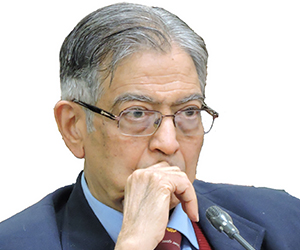An evaluation of the visit to India, from October 20 to October 23, of Nepal’s Prime Minister, Dr Baburam Bhattarai, must take into account not only what he and the Indian side have been projecting but equally of what was done and how it was done.
On symbolism the visit cannot be faulted. Dr Bhattarai came with his wife at the head of a large 37 member delegation including several ministers. During the visit apart from the delegation level talks he had a one on one meeting with Dr Manmohan Singh, who also hosted a banquet in his honour, and had meetings with the top echelon of India’s leadership including the President, the Vice President and the Finance, Home, External Affairs and Defence Ministers. Equally important is the fact that Dr Bhattarai’s India visit constitutes his first purely bilateral official visit after assuming office. It is understood that he will also visit China but he has wisely chosen do go there after having been to India.
Both Dr Bhattarai and the Indian side have made out that his visit was very successful. While Dr Bhattarai termed it as “very productive” and the key to “building trust” between the two countries the Indian side called it an “unqualified success”.
The aforesaid assessment could be perceived to be overly optimistic when simply seen through the prism of the two agreements and the MOU signed during the visit. The MOU is for a Rs1.875 crore Indian grant for goiter control. The two agreements concluded are much more substantive. Under one India would provide a $250 million soft loan for infrastructure development and under the other investments of each country would inter alia be provided national treatment in the other including compensation in the event of nationalization or damage in the event of war, conflict etc. The latter was concluded to take care of the concerns of Indian industry which has had to face attacks by Maoist elements. None of these agreements can be termed as game changing. The quantum of the soft loan though sizeable is far smaller than the amount of assistance being provided by India for other neighbours like Bangladesh, Afghanistan, Sri Lanka or Myanmar.
Some of the agreements which could and should have been inked particularly from India’s point of view were the Double Taxation Avoidance Agreement, the Extradition Agreement and the Mutual Legal Assistance Agreement. Their non conclusion could be seen by some as a sign of Nepal’s reluctance to move forward on issues of concern to India.
The absence of any far reaching agreements arrived at while at one level explicable by the underlying tensions which have bedeviled India-Nepal relations for some time is, of course, also due to the fact that Dr Bhattarai’s government is shaky and its longevity uncertain. With a mandate of only up to end November, and with no certainty that it will be able to get a further few months extension in order to deliver on the peace process and on constitution making, it is living on borrowed time. This fundamental reality no doubt constrained Bhattarai from taking any bolder moves to upgrade India-Nepal ties and perhaps similarly induced India to go slow.
Nevertheless as apparent from a careful reading of the Joint Press Statement issued on Dr Bhattarai visit to India it is quite clear that an effort has been made by both sides to put the past behind them and get the relationship back on the rails. In this context, specific mention may be made of the following elements contained in the Joint Press Statement:
1. The decision that all bilateral institutional mechanisms “be revitalized and convened regularly”. In this regard particular mention was made of early meetings of Joint Ministerial Commission on Water resources, Home Secretaries, and inter Governmental Committee of Commerce Secretaries.
2. The receptivity shown by India to requests made by Nepal for enhanced connectivity and transit facilities as well as additional electricity supply. India also made known its readiness to provide assistance for “priority development projects” as requested for by Nepal.
3. The willingness of the two sides to the establishment of an “Eminent Persons Group to look into the totality of India-Nepal relations and suggest measures to further expand and consolidate” them.
4. Establishment of a Foreign Secretary level committee to “review, adjust and update the 1950 Treaty of Peace and Friendship and other agreements.”
5. Nepal “assured that it would not allow its territory to be used for any activity against India” and India provided a reciprocal assurance.
In view of the foregoing it would be reasonable to conclude that Dr Bhattarai’s visit to India, while no game changer, has been useful in terms of easing tensions between the two countries and paving the way for creating a climate in which improvement of India-Nepal ties can be facilitated through a revival of existing institutional links and creation of new mechanisms. It has also been helpful in underlining that India is prepared to do business with a Maoist regime and favours the evolution of Nepalese on a consensual and inclusive basis. This cannot but have a very favourable psychological impact in Nepal.
-----------------------------------------
Published Date: 31st October, 2011










Post new comment